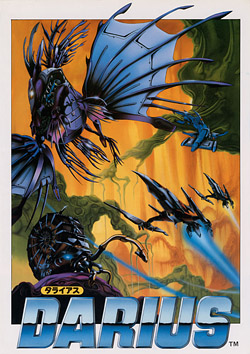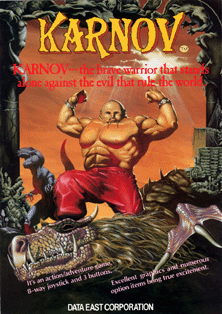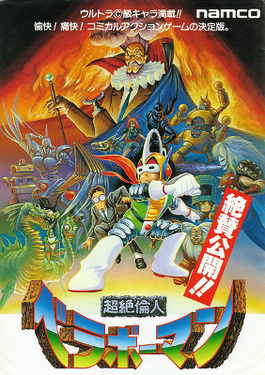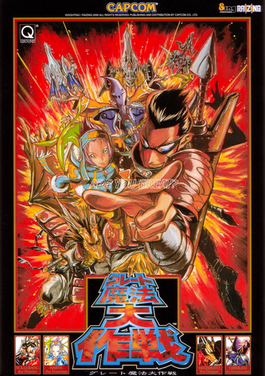Gameplay
Players control a giant flying robot that can walk along the surface of each level as well as crouch. The robot is equipped with bombs to fire from its back and guns to shoot simultaneously. By collecting A items, the robot can transform into a ship which had the advantage of adding one extra point of health and increasing speed. However, once the player transforms into the ship, the ship can not brush against the surface of the level or it would count as a hit. Despite that, the surface will disappear during boss fights, yet the ship and its bombs can still detect it, though the ship will not be damaged by it.
Any mechanical animals assisting the player during the robot form will converge with the robot once the A item was collected, combining their firepower. The levels contain checkpoints, though an on-screen map also shows the player how close to the end they are. While destroying enemy waves, there is always a midsection composed of various barriers that the player needs to avoid getting hit by such as asteroids and ice-blocks. During a boss fight, the map will change to the boss' health meter. Extra lives are awarded with every 100,000 points.

Darius II is a 1989 arcade shooter video game developed and published by Taito. It is a direct sequel to the 1987 title, Darius. It was later released as Sagaia in Japan in 1991 for the Game Boy as well as non-Japanese ports. A remake was released for the PC Engine Super CD-ROM² as Super Darius II in 1993.

Darius is a 1987 horizontal-scrolling shooter arcade game developed and published by Taito. Players control a starship named the Silver Hawk in its mission to destroy the Belser empire before they wipe out the planet Darius. Its gameplay involves traversing through a series of scrolling levels while destroying enemies and collecting power-up icons. It is notable for its unique three-screen panoramic display, upbeat soundtrack, and cute anime-influenced graphics.

Karnov is a platform game released in arcades in 1987. A Nintendo Entertainment System port followed. Players take control of the title character Jinborov Karnovski, or "Karnov" for short. Karnov is a strongman popularly illustrated as being from an unspecified part of the Soviet Union's Central Asian republics as shown on the arcade flyer and again in Karnov's Revenge.

Tomohiro Nishikado is a Japanese video game developer and engineer. He is the creator of the arcade shoot 'em up game Space Invaders, released to the public in 1978 by the Taito of Japan, often credited as the first shoot 'em up and for beginning the golden age of arcade video games. Prior to Space Invaders, he also designed other earlier Taito arcade games, including the shooting electro-mechanical games Sky Fighter (1971) and Sky Fighter II, the sports video game TV Basketball in 1974, the vertical scrolling racing video game Speed Race in 1974, the multi-directional shooter Western Gun in 1975, and the first-person combat flight simulator Interceptor (1975).

Bubble Symphony, also known as Bubble Bobble II, is an arcade video game in the Bubble Bobble series developed by Taito in 1994. While being a new Bubble Bobble for a new generation, it takes place after Parasol Stars.

Chōzetsurin Jin Bravoman is a 1988 beat'em up arcade video game developed and published in Japan by Namco. Described as a "comical action game", the player controls the titular character, a bionic superhero with telescopic limbs, as he must defeat the villainous Dr. Bomb before he takes over the world. Bravoman can use his arms, legs and head to defeat enemies, and can also crouch and jump over them. The game ran on the Namco System 1 arcade board.

Bubble Memories: The Story of Bubble Bobble III is a video game by Taito released to arcades in February 1996. It is the sequel to Bubble Symphony and is the fifth Bubble Bobble game. Unlike Bubble Symphony, this game stars only two dragons, Bub and Bob, like the original Bubble Bobble. It was released in 2007 for PlayStation 2 in Japan only as part of the Taito Memories II Volume 1 compilation.

Space Dungeon is a multidirectional shooter released in arcades by Taito in 1981. Designed and programmed by Rex Battenberg, it was available both as a conversion kit and full arcade cabinet. An Atari 5200 port was released in 1983.

RayForce is a vertically scrolling shooter by Taito for the Taito F3 arcade hardware and released in 1994. It was ported to the Sega Saturn in 1995, Microsoft Windows in 1997, then rereleased for iOS in 2012 and Android in 2017.

Demon's World is a 1989 run and gun arcade video game originally developed by Toaplan and published in Japan by Taito and in North America by Catalina Games. In the game, players assume the role of two ghost hunters to fight against several ghosts and monsters that were unleashed upon Earth by the titular demon king. Initially launched for the arcades, the title was then ported to the PC Engine Super CD-ROM² by NEC Avenue and published exclusively in Japan on 26 February 1993, featuring various additions and changes compared with the original release.

Captain Silver is a side-scrolling hack and slash platform game released as an arcade video game by Data East in 1987. Home versions were published for the Master System by Sega and for the NES by Tokuma Shoten.

G-Darius is a shoot'em up arcade game, released by Taito in 1997. It is the fourth arcade installment of the Darius series and the first in the series to feature three-dimensional polygonal graphics.

Dimahoo is a medieval-themed manic shooter video game developed by 8ing/Raizing and published by Capcom on the arcade cabinets in 2000. It was released in Japan as Great Mahou Daisakusen. It is a sequel to 1993's Sorcer Striker and 1994's Kingdom Grand Prix. The game's soundtrack was published by Suleputer.

B-Wings is a vertically scrolling shooter first released as an arcade video game by Data East in 1984. A version was released in 1986 for the Family Computer. It was Data East's very first home release for the console.

Superman is a 1989 arcade action game released by Taito and featuring the DC Comics character Superman. While not directly based on the original film series, throughout much of the game the "Superman Main Theme" and "Can You Read My Mind" from the Superman films are used as background music.

Slap Fight is a 1986 vertically scrolling shooter arcade video game developed by Toaplan and published by Taito. Set on the colonized fictional planet of Theron in the future, where an alien race led by Gaudy have invaded the human-controlled location, players assume the role of an Allied League of Cosmic Nations (ALCON) fighter pilot taking control of the SW475 space fighter craft in an effort to counterattack the invaders. Initially launched for the arcades, the game was later ported to other microcomputer and console platforms by various third-party developers, with each one featuring several changes or additions compared to the original release.

Gekirindan is a 1995 vertically scrolling shooter arcade video game originally developed and published by Taito in Japan, America and Europe. Set in the year 3195, where a robot known as "Huge Boss" stole a newly developed time machine to travel back in time and rewrite human history, players assume the role of one of the six fighter pilots taking control of their own space fighter craft in an effort to overthrow the evil entity from altering history.
Heavy Unit is a horizontally scrolling shooter arcade video game developed by Kaneko and published by Taito in 1988. It was ported to the PC Engine by Taito and was released on December 22, 1989. There was also a Mega Drive port by Toho entitled "Heavy Unit: Mega Drive Special" released on December 26, 1990. The player takes control of a star ship that can transform into a mecha by obtaining a specific type of power up.

Syvalion is an arcade shooter video game released by Taito in 1988 and designed by Fukio Mitsuji, creator of Bubble Bobble. The player controls a golden metal dragon which flies around, breathing fire at its enemies while collecting power-ups to recharge its fire. The enemies are robots and tanks. At the end of each level, the player fights a boss.
Let's! TV Play Classic is a series of Japan-only plug & play devices developed and distributed by Bandai programmed on XaviX software created by SSD Company Limited in 2006 that contain arcade games from either Namco or Taito, with Namco's being called "Namco Nostalgia" while Taito's are called "Taito Nostalgia". Each device in the series contains 4 games, with 2 being classic arcade games while the other 2 are new games using the original game's sprites developed by Bandai.

















